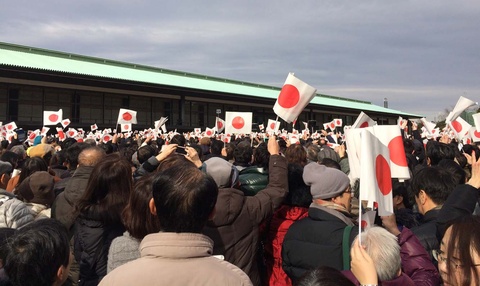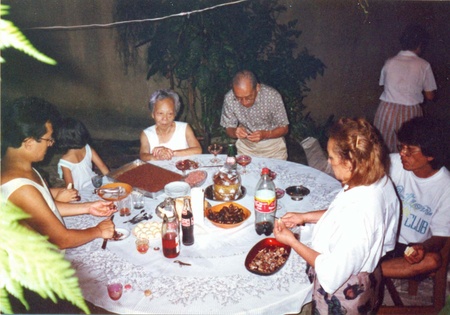Until a year ago, I had an idea of what the New Year tradition is like in Japan ( shogatsu ). The date is important in the country because it is religious. And when I traveled there, I saw some of this celebration up close.
It was an interesting and different experience, because I realized that Japanese-Brazilians only maintain some customs that are strong in their families' country of origin.
Bonenkai and shinnenkai, the end of year festivities
In Japan, there is a tradition of New Year's Eve parties. Bonenkai is an event to bring together families, friends, company employees, among others, for a great celebration. Shinnenkai aims to celebrate the beginning of a new year – which can also be a meeting between all these groups of people to wish them luck, abundance and happiness.
When I worked at Bunkyo (Brazilian Society of Japanese Culture and Social Assistance), I was introduced to these two celebrations. I had the experience of participating in the entity's bonenkai , with dinner, music performance and a toast. Regarding shinnenkai , I heard and read reports that the ceremony is attended by the consul general of Japan, accompanied by his wife, and includes the banzai sanshou , which are the three cheers to welcome the New Year, and the kampai , which It's the toast.
My friends and I made there organized our own parties and even met with non-descendant friends and acquaintances who were in some way linked to Japanese culture.
Japanese customs
New Year's Eve is a very important date in Japan and the festival lasts approximately three days. This is the time when the Japanese perform purification, prayers and welcome the new year. Additionally, families watch the traditional Kouhaku Utagassen, a music show with famous singers.
I learned in a Japanese school class that preparations begin a few days in advance. Housewives do extensive cleaning of their homes, called souji , a type of purification. This is because to enter the new year you need to have everything clean.
Religiosity in Japan's New Year
Joya no kane is the ceremony celebrated on the night of December 31st, which consists of ringing the bell 108 times, with the last ring at midnight. The chimes represent the 108 worldly desires ( bonno ). Thus, ringing the bell aims to ward off these desires so that man is purified in the new year.
In Tokyo, Japanese people usually spend New Year's Eve near the Tokyo Tower, an icon of the city and where the countdown to the arrival of the new year takes place. I also went nearby, to the Zozoji temple, when I was traveling through Japan. Seeing the tower all lit up, announcing 2015, was exciting!
Early in the morning of January 1st, the Japanese make their first visit to Buddhist temples and Shinto shrines, called hatsumode . Still on my trip to Japan, I went to the Kawasaki Daishi Temple in Kanagawa Prefecture, in the south of the country, one of the most visited in the first three days of the year. In 2013, it received 2.98 million people, according to information from the Japanese Embassy in Brazil. And it was really full, even though the weather was cloudy with a light snowstorm.
Afterwards, we went to the Imperial Palace to greet the emperor, an event that only happens twice a year – on the emperor's birthday, December 23rd, and on New Year's Day, January 1st.

The Japanese also have the custom of placing kagamimochi – two mochi , one on top of the other, decorated with Japanese paper, matsu (pine) leaves and daidai (Japanese orange) – on an altar, as a form of thanks to the Buddhist and Shinto gods. . I remember my paternal grandmother did this at her house, but without the altar.
In the Liberdade neighborhood, in São Paulo, every year on December 31st, Moti Tsuki Matsuri is held. During the festival, around 20,000 bags of mochi are distributed to the public and 3,000 bowls of ozoni (soup with prosperity dumplings) are offered.
In addition, the program includes the celebration of a Shinto religious ceremony and the performance of the mochi punching ritual, in which the authorities present are invited to participate. The ceremony at Liberdade Square ends at noon, when in Japan it is midnight.
My family traditions
Here in Brazil, most people wear white clothes on New Year's Eve to attract peace. As a child, when I spent the day with my family, at one of my grandmothers’ houses – with my uncles and cousins –, we even followed this tradition, but little by little we lost it. We greeted each other, saying omedetou – which, in reality, comes from the expression Akemashite omedetou gozaimasu , a thank you for the requests fulfilled in the year ending.
Another custom we had was to include some Japanese foods (such as makizushi , rice rolled in seaweed, and manju stuffed with azuki , which has rice in the dough and a sweet bean filling) in the New Year's dinner menu. According to my father, for my grandmother, there always had to be Portuguese chestnuts, a tradition that existed in her family due to Brazilian influence, perhaps because of a close friend. One memory I have is seeing my grandmother in the kitchen, where she would spend hours preparing dishes that only she made herself, like the pink gohan dumplings with adzuki beans. My sisters and I loved it!
Nowadays, when the end of the year approaches, we worry about tidying up the house. Starting a new year, a new cycle, with new (and good) energy.
Supper is prepared in the afternoon so that everything is ready in the evening. Meanwhile, we follow the celebrations in other countries, including Japan, on television or even on the Internet. And, when the clock strikes midnight, we watch the fireworks in the neighborhood and in Brazilian cities live on TV. On the first day of the new year, we take the opportunity to rest, as it is a public holiday.

© 2015 Tatiana Maebuchi






